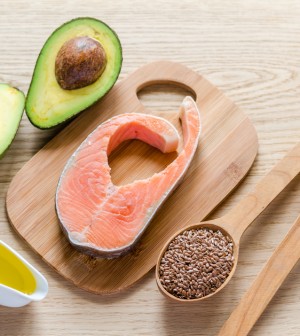- Beneath the Surface: Revealing Life’s Goals nurtured from a Spiritual SeedPosted 2 days ago
- How We Kept Marital Peace while Traveling the World with Our KidsPosted 2 weeks ago
- How I Coped with Feeling Lost in a Changing SocietyPosted 2 weeks ago
- The Unexpected Liberation of a Butt DialPosted 1 month ago
- Why is France making abortion a constitutional right?Posted 2 months ago
- Being a WomanPosted 2 months ago
CHERISH GOOD FATS

Written by Joan Borysenko
“You, as a food buyer, have the distinct privilege of proactively participating in shaping the world your children will inherit.”
— Joel Salatin, Holy Cows and Hog Heaven: The Food Buyer’s Guide to Farm Friendly Food
Chickens raised outside in a pasture get to scratch around in the dirt, eat insects, gobble up worms, and hob nob happily with their flock. The eggs laid by these back-to-the-earth mama hens have a better fat composition than factory farmed eggs, including as much as 20 times more healthful omega-3 fatty acids.
But when you buy a dozen eggs at the store—eggs marked natural, organic, cage-free, humanely raised, or vegetarian what does the label promise actually mean? Can you trust those bucolic pictures of hens pecking around the base of a tree, or does cage-free mean theoretical access to the outside through a tiny door that’s rarely used? Does vegetarian feed consist of pesticide-ridden cottonseed hulls or meal? The word natural is meaningless, as there are no regulations that back it up. The word organic, on the other hand, is tightly regulated.
But we also need to consider ethical realities. A hen who eats organic food but lives as a debeaked prisoner in a crowded cage is not a happy camper.
A website called Cornucopia has an egg-rating system that considers nutritional and ethical questions (www.cornucopia.org/organic-egg-scorecard/). A 5-egg rating is “exemplary,” generally given to eggs from small- to medium-scale family farms where hens enclosed in mobile pens are rotated frequently to fresh pasture. A 1-egg rating, in contrast, generally refers to store brand or private label eggs rated as “ethically deficient.” Cornucopia explains, “Our research indicates that the vast majority of organic eggs for private label brands are produced on industrial farms that house hundreds of thousands of birds and do not grant the birds meaningful outdoor access.”
I believe that it’s our responsibility to treat animals kindly, a civil rights issue that’s inspiring more conscious food choices by younger consumers and baby boomers alike. We vote for the state of animals and for our own health through what we buy.
Although a dozen eggs from our local family farm costs about $7.99—more than double the price of other “premium” wannabe-organic-looking eggs—we bite the bullet and buy the ethical eggs. It was a shock to read on the Cornucopia site that Whole Foods 365 organic brand eggs only get a 1-egg rating. They’re factory farmed, as are eggs from Trader Joe’s, the Safeway Organics line, Eggland’s Best, and dozens of other brands—some of which are even labeled as if they come from family farms.
If you do choose to eat ethical eggs, one thing you can be sure of is that they contain a wealth of good fats for you since, as food guru Michael Pollan says, “You are what what you eat eats.” So let’s turn our attention to which fats are good for us to eat and why that’s so.
Omega-3 Fatty Acids
We hear all the time that we ought to eat fatty fish—that two servings a week will actually prolong life. The health benefits, as you’ll find out momentarily, really are impressive. My mother loved canned salmon and sardines so much that one or the other was almost always her go-to food at lunchtime. If you’re fortunate enough to like canned sardines, they’re a very convenient source of omega-3’s. They’re also an environmentally sustainable choice. Sardines are small fish, there’s an abundant supply in the wild, and because they’re near the bottom of the food chain their mercury content is low.
Just as omega-6 fatty acids are named for where in the carbon chain unsaturated double bonds occur, so are omega-3 fatty acids. I’ll spare you the details. There are, however, several types of omega-3 fatty acids that vary in chain length and degree of unsaturation. Two types of omega-3s—EPA (eicosapentaenoic acid) and DHA (docohexaenoic acid)—occur primarily in fish, but there are vegetable sources as well. Vegans can get DHA from marine algae supplements. EPA can be made by the body in very small quantities from ALA (alpha-linolenic acid) found in walnuts, flax, chia, and hemp seeds.
While there’s no controversy about whether omega-3’s are good for you, there is a controversy about how much omega-6 versus omega-3 fatty acids you need to keep your body healthy. The majority of people, as you now know, consume about 75 times more vegetable oil rich in omega-6 fatty acids than our grandparents or great-grandparents did. At the same time, the great majority of Americans consume too little healthful omega-3 fatty acids either from fatty fish, algal supplements, krill or fish oil supplements.
The result is that the balance of our fatty acids, at least according to some experts, is seriously off kilter. Most integrative medical professionals will tell you that the ratio of omega-6: omega-3 fatty acids should be 1:1, or at most 4:1. In contrast, the typical American diet has a ratio that approximates 20:1.
Conventional nutrition researchers and government agencies vociferously disagree, possibly because the PUFAS-are-healthy-so-eat-a-lot-of-them myth persists in the face of excellent data to the contrary.
The AHA Eats Their Words
An article about the BMJ study appeared in Science Daily, a website that covers the latest research news. The reporter noted that,
The most common dietary PUFA in Western diets is omega-6 linoleic acid (n-6 LA for short). UK dietary recommendations are cautious about high intakes of omega 6 PUFAs, but some other health authorities, including the American Heart Association, have recently repeated advice to maintain, and even to increase, intake of omega-6 PUFAs. This has caused some controversy, because evidence that linoleic acid lowers the risk of cardiovascular disease is limited.2
The article goes on to quote one of the authors of the BMJ study who argues against the “saturated fat bad, omega-6 PUFA good” dogma and suggests politely that the American Heart Association guidelines on omega-6 PUFAs may be misguided. The authors also “underscore the need to properly align dietary advice and recommendations with the scientific evidence base.”
When the BMJ article was published, the blogosphere resounded with salvos from both sides of the polyunsaturated fat fence. The article is suspect. No, it’s the Holy Grail—one more nail in the PUFA coffin. What’s the bottom line? Research studies need to be replicated to make sure that associations haven’t appeared by chance, and to rule out a variety of other errors. That takes time. So for now the fat wars continue to rage.
Just as I was putting the finishing touches on this book, a small crack in the low-fat wall finally opened. The 2013 guidelines on cholesterol, blood pressure, and obesity management compiled by the National Heart, Lung, and Blood Institute (NHLBI), reversed the recommendation to lower fat intake overall. The NHLBI lifestyle recommendations are now more in line with a Mediterranean type diet based on plants, some whole grains, and healthy fats including olive oil, nuts, seeds, fish oil, and avocados.
Let’s take a closer look at some of the good fats.
Olive Oil
I consider olive oil a super food. It’s a monounsaturated fatty acid (MUFA), so it’s more stable and less prone to oxidation than the PUFAs. A Mediterranean diet, arguably one of the healthiest diets overall, is rich both in olive oil and in omega 3’s from seafood. Olive oil is not only healthful, as we’ll review in a minute, but it’s also delicious. In addition to being healthful, fine olive oil is intoxicatingly fragrant and delicious. It adds a subtle, sweet-earthy flavor to whatever foods you add it to.
But it’s important to distinguish between real and fake, good and bad, olive oils.
You need to read the fine print on the label to see what you’ve got. Fake olive oils abound in supermarkets. They’re bottled and labeled to appear like olive oil but may be a blend of olive oil and PUFAs or the olive oil may have been industrially produced using poisonous solvents to leech out the oil, which denatures it. The rancid oil is then deodorized. The resultant “olive oil” has no redeeming features. Instead it promotes inflammation.
Look for organic, cold-pressed extra virgin olive oil. Instead of extracting the oil with chemical solvents, this kind of oil is mechanically pressed from the olives in a process that doesn’t oxidize the oil. The unfiltered variety of cold-pressed oil is cloudy and contains a little sediment. The filtered variety is clear. Either one is great. I suggest buying the best olive oil that your budget can handle, and buying it in glass bottles rather than plastic, since chemicals from the plastic can leech into the oil.
People who consume olive oil as a steady feature of their diet are less likely to develop cardiovascular disease including stroke, high blood pressure, high cholesterol levels, and high triglycerides. Olive oil also helps to preserve the endothelial layer (the inside lining) of blood vessels and reduce inflammation, which may be part of the way it prevents the build up of plaque and fights hardening of the arteries.
Olive oil is also high in a substance called hydroxytyrosol, which is being explored at Houston Methodist Hospital as a preventative for breast cancer in a high risk group of women. An article in Medical News Today sums up some important research on olive oil on the possible prevention and treatment of breast cancer: “The researchers decoded a complete cascade of signals within the cells of breast tumors that are activated by virgin olive oil. They concluded that the oil reduces the activity of p21Ras, an oncogene, prevents DNA damage, encourages tumor cell death, and triggers changes in protein signaling pathways. The team found that while corn oil—which is rich in n-6 polyunsaturated fatty acids—increased the aggressiveness of tumors, virgin olive oil had the opposite effect.”3
The MUFAs in extra-virgin olive oil (EVOO) also help regularize carbohydrate metabolism and dampen down spikes in blood sugar, which as you know, will help reduce the nasty trio of dietary demons—glycation, inflammation, and oxidation. That said, I’ll end this accolade to the olive with a reminder that although olive oil is practically a magic potion, it’s not a substitute for medical care.
Coconut Oil
I turned on CNN one day and there was Chief Medical Correspondent Sanjay Gupta, M.D., looking squirrelly. He was reporting on the purported health benefits of coconut oil despite the fact that it is a—perish the thought for conventional medicine—saturated fat. He concluded that it didn’t seem to be as bad as some other saturated fats.
The fact is that despite extravagant claims for the health benefits of coconut oil—from lessening symptoms of Alzheimer’s disease to promoting weight loss—there are very few studies that have been done to support the largely anecdotal health claims made about this “miracle oil.”
Coconut oil is more saturated, and thus more stable against oxidation, compared to other oils. While coconut oil is 92 percent saturated, butter is only 63 percent saturated, while olive oil trails at 15 percent saturation. The kind of saturated fat in coconut oil is also unusual. It’s a medium chain fatty acid (MCT) rather than a long chain fatty acid. Because MCTs are transported directly to the liver, they are burned as fuel very quickly and may raise metabolic rate slightly. In other words, this is a fat that might help make you skinny. At least that’s the word on the street. But only one small study of 40 women has been done, and more are needed to validate the weight loss claims.
Since I’ve arrived at the point where saturated fat and I have become friends (at least in limited quantities), I use coconut oil in much of my baking. It results in a crispy, tender cookie. And since it’s extremely stable with a shelf life of about five years due to its high percentage of saturation, it’s less likely to become rancid than other fats. That fact alone makes it a good fat in my book.
Avocados and Avocado Oil
Avocado oil is pressed from the fruit of the avocado, not the seed. Avocado flesh, as well as its oil, has abundant phytochemicals and vitamins including A, B1, B2, pantothenic acid, Vitamin E, D, and other micronutrients. It also contains several plant sterols that reduce inflammation. Research has also demonstrated that avocados contain several powerful antioxidants that limit the activity of free radicals.
Avocados are also extremely rich in fiber—about 10 grams to one fruit.
So, harkening back to the five pillars of dietary doom, avocados are a big winner. They:
- reduce inflammation
- reduce oxidative stress
- provide micronutrients
- nourish gut microbes with their fiber
- help normalize blood sugar and reduce glycation by slowing the absorption of carbohydrates
We eat avocados several times a week, adding them to salads often. Gordon also makes spectacular guacamole—a marvelous snack to scoop up with celery, carrots, jicama, or lettuce leaves.
Extra-virgin avocado oil, like olive oil, is high in monounsaturated fats, has a high smoke point so that you can use it to sauté foods, and tastes great. Depending on the brand, some avocado oils are also a good source of the vitamin CoQ10, or ubiquinol, so important for heart health.
***
So now you’ve got the word on bad and good fats. To sum it all up:
- Fats are only as good as the plants or animals they come from. Choose extra-virgin cold-pressed olive, avocado, or coconut oil; and eat eggs, dairy, and meat that come from humanely raised, pasture-fed animals. Eat wild-caught fish that are low in mercury because they’re small or Alaskan wild-caught salmon.
- According to the latest research, saturated fats are good for most people, while the supposedly heart healthy PUFAs are not. Beware, since your doctor (or your body) may not agree.
Now that we’ve safely traversed the turbulent World of Fat, it’s time to turn our attention to the equally contentious and controversial World of Grain. Once you know what the grain flap is all about, then you’ll be in a better position to determine whether or not grains are a Plus food for your personalized nutritional profile.
 Joan Borysenko, Ph.D., is an internationally known speaker in integrative medicine and the mind/body connection. She has a doctorate in cell biology from Harvard Medical School and is a licensed clinical psychologist. The New York Times best-selling author of numerous books, she is also a journalist and radio personality.
Joan Borysenko, Ph.D., is an internationally known speaker in integrative medicine and the mind/body connection. She has a doctorate in cell biology from Harvard Medical School and is a licensed clinical psychologist. The New York Times best-selling author of numerous books, she is also a journalist and radio personality.
Website: www.joanborysenko.com







